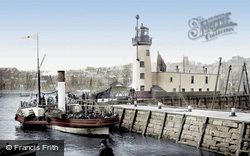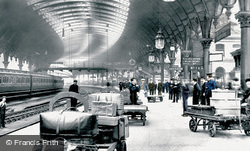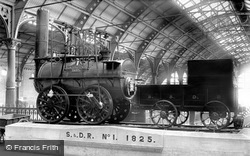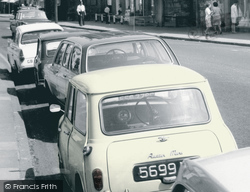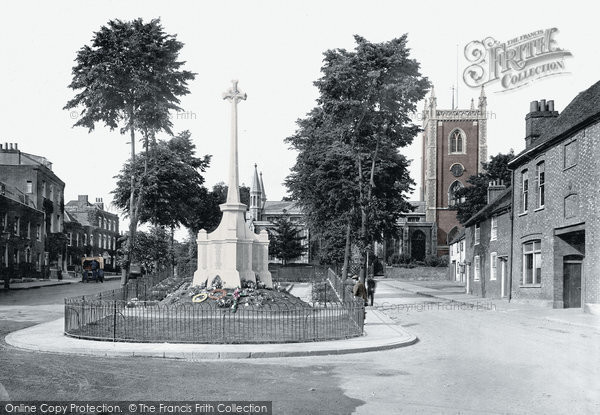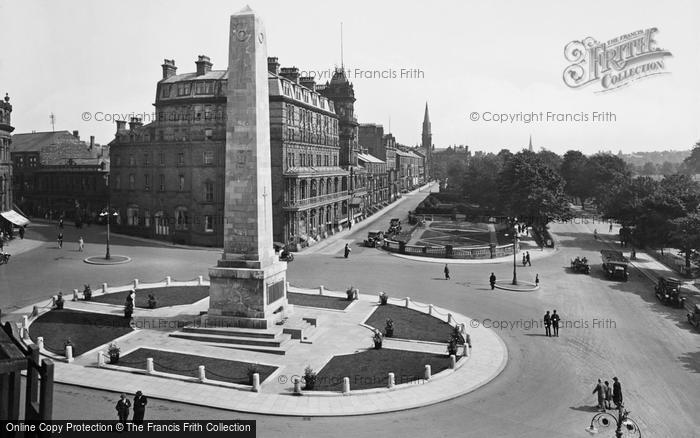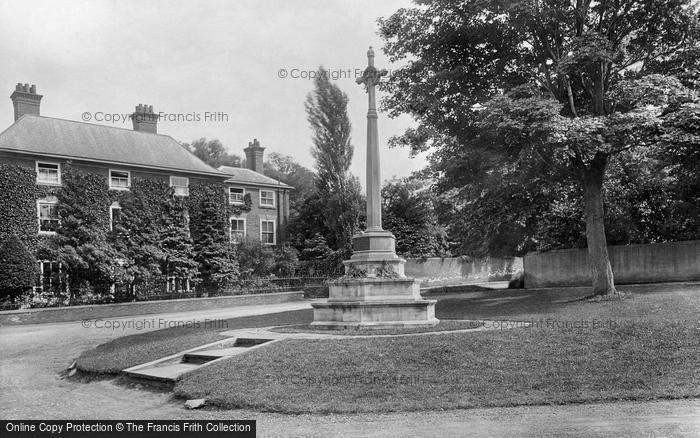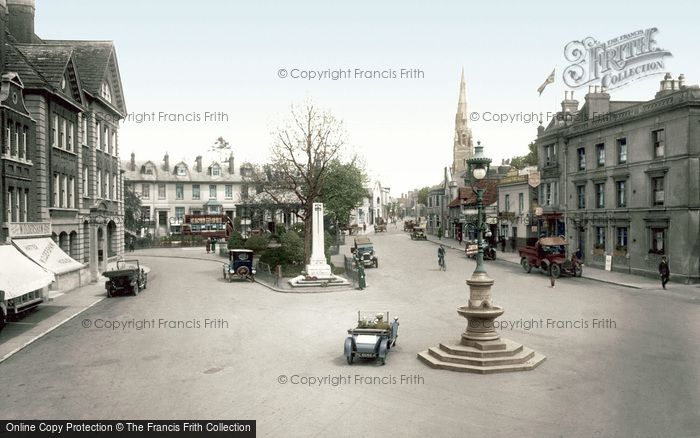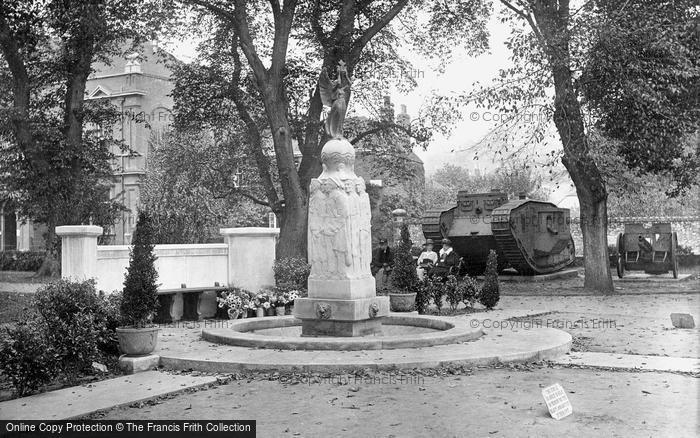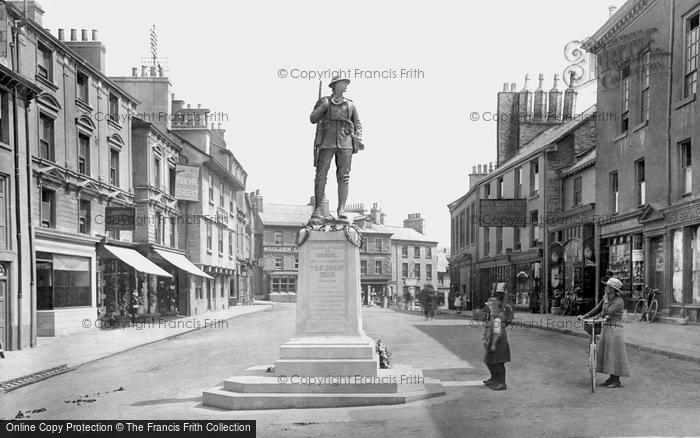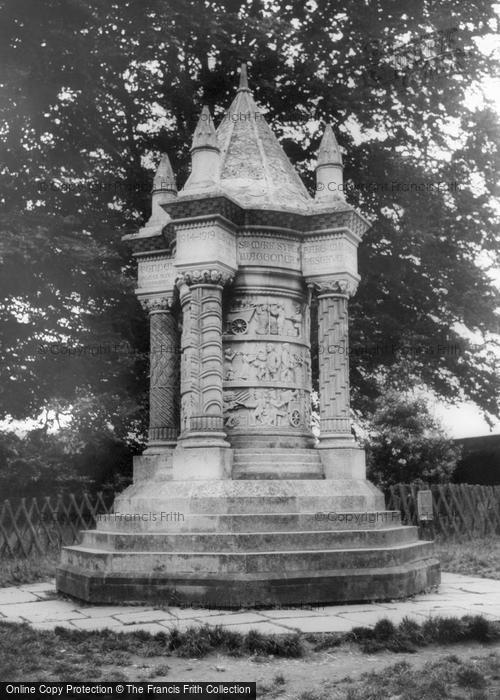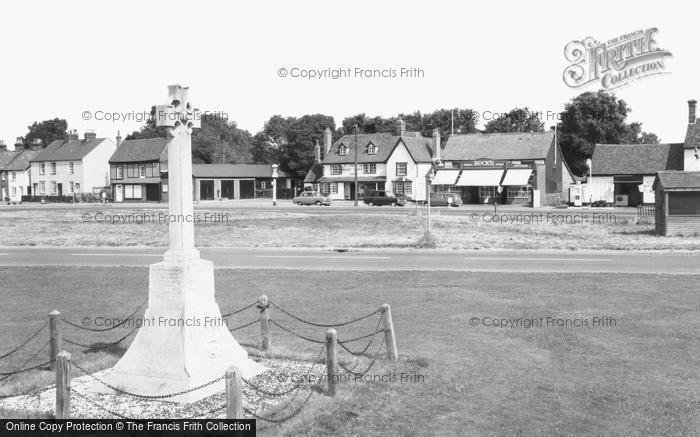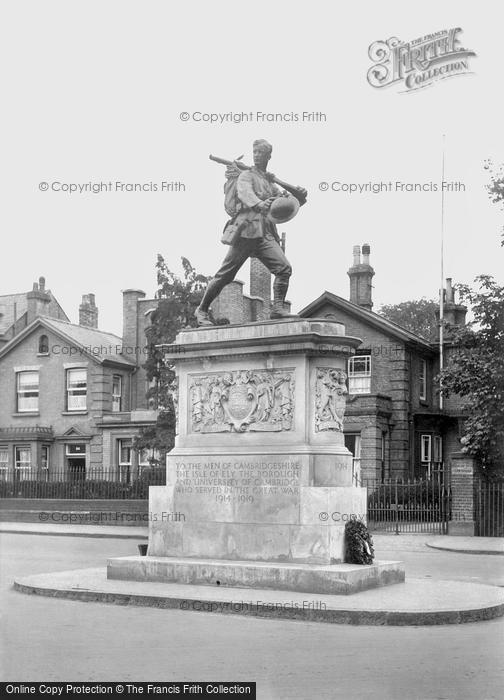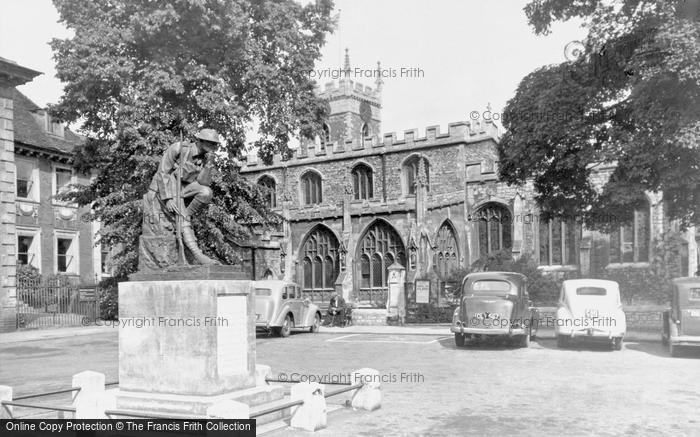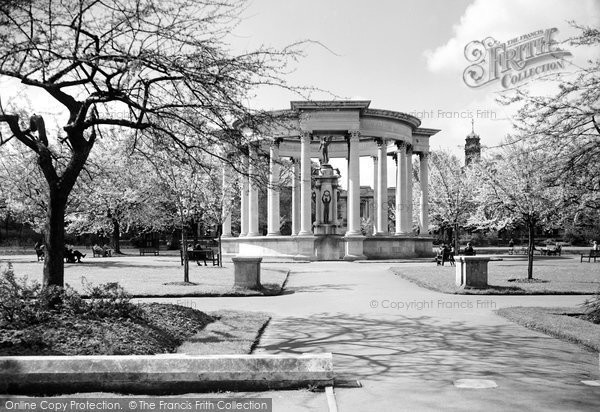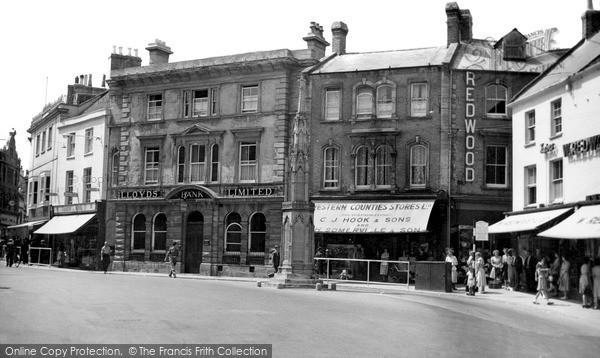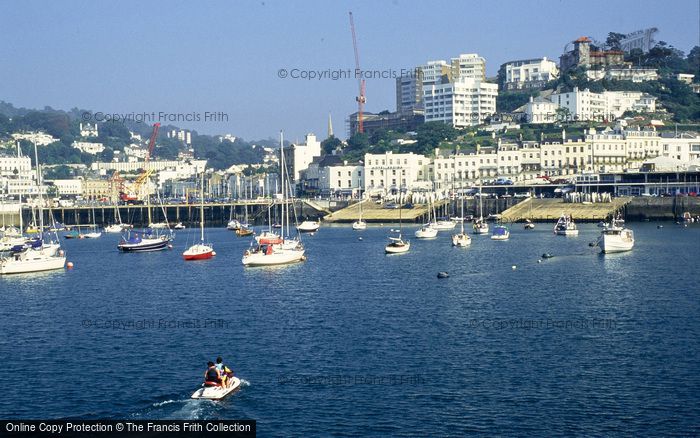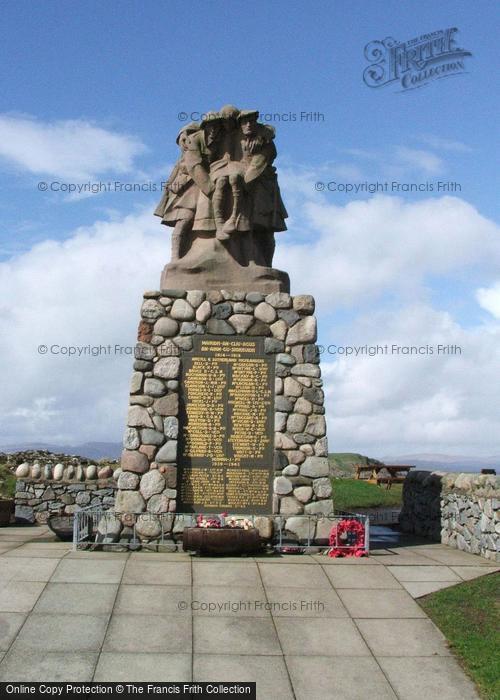War Memorials
Published on
November 10th, 2023
A special selection of photographs from our Archive of the War Memorials that connect us with those who fought and perished in the conflicts that have shaped the world we live in today.
"They shall grow not old, as we that are left grow old: Age shall not weary them, nor the years condemn. At the going down of the sun and in the morning, We will remember them."- Laurence Binyon, For The Fallen
After the First World War of 1914-1918 (then known as the Great War) war memorials were erected in villages, towns and cities all around Britain, all inscribed with sad lists of names commemorating the sacrifice of those who went off to fight and didn’t come home. Many of these appear in the Frith photographs from the 1920s onwards. Some of these are monumental cenotaphs like Harrogate’s, seen here.
Other war memorials erected in the 1920s are simple crosses in small villages like this one in Southwell in Nottinghamshire.
Many war memorial are seen in the Frith photographs from this period in their original locations – as the 20th century wore on, many war memorials were moved to new sites to prevent them becoming traffic hazards as motorised traffic increased, or as town centres were redeveloped. The War Memorial seen in this photo of the Carfax at Horsham in Sussex was erected in 1921 but has since been relocated.
During the First World War, the citizens of many towns took part in fundraising to help the war effort, and the scale of their success was recognised after the war. Towns that did well with fundraising were given a redundant tank in recognition of their success. Hythe in Kent was presented with a Mark IV Male tank (number 164) on 11th July 1919. It is seen here next to Hythe’s war memorial, together with a field gun. The tank was removed from the memorial gardens in the late 1920s.
Kendal’s dead from the First World War were honoured with their 316 names inscribed on a cenotaph war memorial erected in 1921 on the site of the old library in Market Place facing Stricklandgate. A large company attended its unveiling on 1 July 1921, with a contingent of children dressed in white singing hymns with the crowd to the accompaniment of a portable organ mounted on a cart.
Sledmere House near Driffield in East Yorkshire has been the home of the Sykes family since the 18th century. The monument shown in this photograph stands opposite Sledmere House. Erected in 1919, it commemorates the Wagoners’ Reserve Corps of 1,127 local farm workers who joined Sir Mark Sykes’s private army as wagon drivers in the First World War. The Wagoners’ Museum in Sledmere House chronicles their story.
"This not so much a memory of mine as I am too young to actually remember Norman Layfield, but his name is among the list of brave young men who left the Heath and went to fight in the Second World War, he was the younger brother of my grandfather. They were in different regiments but actually ended up in the same POW camp on the famous River Kwai in Thailand after being captured by the Japs. Grandad had no idea that Norman was there, up till this point he had believed that Norman was safe at home in Hatfield Heath, thousands of miles away from the disease, squalor and torment that tens of thousands of Allied solders were being worked to death in. On discovering that Norman was there, as the older brother he applied to have his brother transferred to his regiment. This was possible as an older member of the same family is entitled to claim the younger member into his regiment. Sadly, when Grandad applied for his brother’s transfer he discovered that Norman had died a few days earlier, he had died of a tropical disease as among other things he had been drinking from the polluted river. This was something that Grandad never got over, he rarely spoke of Norman and he never had a photo of his brother on display in the house, as it was far too painful for him to cope with. Grandad went to see the film ‘The Bridge on the River Kwai’ that was made in the 1950s, and as the film rolled he sat there and wept, the portrayal of the erection of the bridge was so far away from the truth it was beyond belief to anyone that was actually there. This is a sad piece of local history, but if you happen to be on the Heath any time you will know how at least one of the names on the memorial got there – Norman Layfield."
With thanks to Antony Garrett for sharing this personal story of one of the names on the War Memorial at Hatfield Heath."
The War Memorial in Hills Road at Cambridge is by Tait Mackenzie and was unveiled in 1922. Prominently sited at a crossroads, the memorial is dedicated to the ‘Men of Cambridgeshire, the Isle of Ely, the Borough and University of Cambridge’. The unusually informal and naturalistic design represents a bare-headed, long-striding soldier, and is titled ‘Coming Home’.
‘The Thinking Soldier’ war memorial on Market Hill in Huntingdon was designed by the sculptress Lady Kathleen Scott, the widow of Captain Scott, the Antarctic explorer who died in 1912.
Simple yet unusual and striking, The Welsh National War Memorial is situated at Cardiff in the Alexandra Gardens part of Cathays Park. It is a double circular colonnade enclosing the Cenotaph. It was designed by J Ninian Cooper and unveiled in June 1928 by the Prince of Wales.
A soldier is seen walking along the road towards the war memorial in this 1950s’ view of Yeovil in Somerset; he was probably based at Houndstone Camp on the outskirts of the town. Yeovil’s war memorial to the local men who died in the First World War was unveiled on 14 July 1921. It was built from local Hamstone and designed in the style of an Eleanor Cross. After the First World War, the term ‘Thankful Villages’ was used for villages where all the local men who went off to fight in the war returned alive when the conflict was over. Somerset has the highest number of Thankful Villages in the UK, but even so there were only 9 places in the entire county where no men were killed in the dreadful conflict: Aisholt, Chantry, Chelwood, Priddy, Rodney Stoke, Stanton Prior, Stocklinch, Tellisford and Woolley. The sad lists of names inscribed on war memorials in other villages and towns in Somerset and elsewhere all around Britain commemorate the men who didn’t come home – there are 226 names on Yeovil’s memorial.
Nowadays Torquay’s harbour in south Devon is popular as a tourist and marine resort, but during the Second World War Torquay was an embarkation point for American troops for the Normandy landings on D-Day, 6th June 1944. On the north side of the harbour, at Beacon Quay, you can still see two broad concrete slipways leading into the water that were built for the embarkation of troops from the 4th US Infantry Division onto LCTs (Landing Craft Troop) on 5th June 1944, bound for ‘Utah Beach’. The slipways were built in 1943 by British Royal Engineers who later financed the building of the nearby D-Day Embarkation Ramps memorial wall. They are possibly the best-surviving examples of D-Day fabric in the country, and are now Grade 2 listed historic monuments.
This powerfully emotive war memorial stands on the Corran Esplanade at Oban, on the west coast of Scotland. It is inscribed with the names of 174 men from Oban who gave their lives during the First World War. Sadly, the names of a further 73 men were added after the Second World War, and subsequently the name of a local man who died in the Falklands War. The statue shows two kilted comrades supporting a wounded comrade between them.
Perhaps you'd like..?
If you liked our "War Memorials" Blog Feature, you might like to see and follow this
Francis Frith board over on Pinterest.
Join the thousands who receive our regular doses of warming nostalgia!
Have our latest blog posts and archive news delivered directly to your
inbox.
Absolutely free. Unsubscribe anytime.

